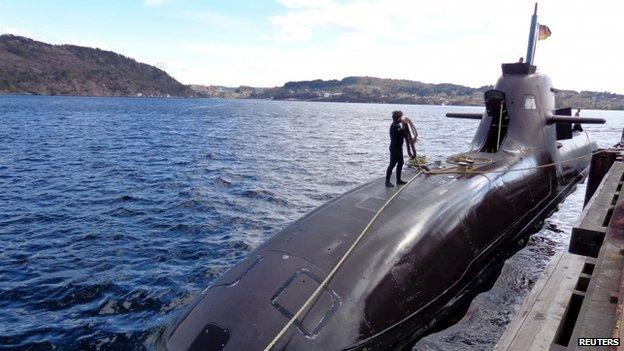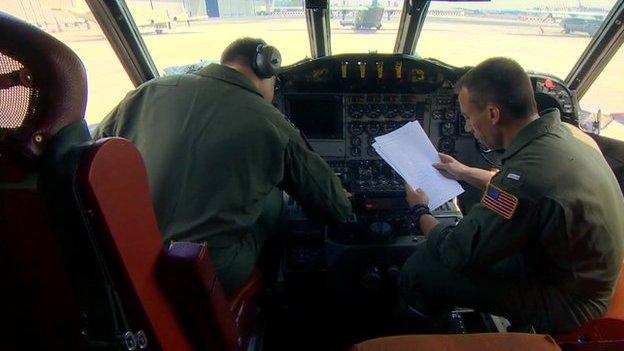Nato's 'Dynamic Mongoose': Hunting for submarines
- Published
Jonathan Beale gets a close-up look at the latest sub-hunting technology
In the North Sea, off the coast of Norway, Nato has been conducting its largest ever anti-submarine warfare exercise.
It is seen as a response to the growing threat from Russian submarines which have stepped up their own patrols in these very same waters.
It has also highlighted a gaping hole in Britain's own defences.
For now though it is the hunt for U33, not Red October. The German U-boat is acting as the unseen enemy below the waves.
'Important training'
U33's commander Kai Nicklesdorf and his 28 crew, who live in cramped conditions, are trying to avoid detection by 10 Nato warships.
Their task, for this exercise, is to try to take out the command ship, the USS Vicksburg, and an oil tanker.
When they dive the only visible sign of their presence will be the brief sight of a periscope breaking the waves for a matter of seconds.
Up on the bridge of the USS Vicksburg, Rear Admiral Brad Williamson prepares his fleet of 10 warships, including the Royal Navy Frigate HMS Portland, to begin the search.

On the USS Vicksburg, the crew scan the horizon looking out for a periscope

German Navy submarine U33 is acting as the unseen enemy below the waves in the exercise
He says this is important training and that his crews are all aware of Russian submarine activity.
There have been recent reports of Russian submarines off the coast of Sweden, Finland and the UK.
He says the training "focuses our minds and for the guys in combat it's not theoretical that we might have to do anti-submarine warfare".
For the surface ships the task of locating an invisible enemy under vast stretches of ocean is not that easy.
It has been likened to looking for a needle in a haystack.
Up on the bridge of the USS Vicksburg, the crew scan the horizon looking out for a periscope.
Down below, in a darkened room in the bowels of the ship, sailors listen in and monitor the results from the ships sonar and sensors.
Lieutenant Colin Ryan, Vicksburg's anti-submarine warfare officer, admits that it is much easier for a submarine to hide than a surface ship.
He says there have been incidents on this deployment when they have identified submarines.
But when I ask whether they have been Russian, he replies nervously: "I wouldn't want to comment on that," before adding: "In general, we're always on the lookout."

The crew aboard the U33 are trying to avoid detection by 10 Nato warships
Nato members rarely comment on the activities of their own submarines, let alone the movements of any potential enemy.
But this exercise is proof there is growing concern about Russia's increasing military strength.
While many European nations have been cutting their defence budgets and the capabilities, Russian President Vladimir Putin has been heavily investing in his.
Russia now has a fleet of around 60 submarines - the larger nuclear powered ones and smaller diesel electric submarines which can operate in shallow waters.
'Challenging adversary'
Earlier this month Russia launched what it claims is the "quietest submarine in the world".
Peter Roberts, a former Royal Navy officer, and now a senior fellow at the defence think tank RUSI, says it now leads the world in submarine development.
He describes them as technologically advanced and their crews as highly skilled.
They are, he says, the "quietest and most challenging adversary in the world".
When out on patrol they can go undetected for months at a time.
Often the first time a Nato warship will be aware of their presence is when a periscope briefly pops above the waves.
They lie silent and stationary at the bottom of the ocean listening to and "fingerprinting" other nations' submarines and warships.
For this exercise, curiously named "Dynamic Mongoose", as well as the warships there are anti-submarine warfare helicopters helping in the search.

US Navy sailors on board the USS Vicksburg off the coast of Norway
For the first time, a Nato research vessel has also deployed underwater unmanned vehicles or drones to help track the ocean.
Scientists on board listen to the familiar pings as the two robots shaped like torpedoes scan the seabed.
It is not always easy to distinguish between the shipwrecks, whales, fish shoals and rocky outcrops in the sea.
'Key vulnerability'
Ryan Goldhahn, scientist-in-charge at Nato's Centre for Maritime Research and Experimentation, says the underwater robots, which appear on their monitors as Harpo and Groucho, have several advantages to the warships and aircraft involved in the exercise.
They are cheaper to operate, take the person out of harm's way and can offer persistent surveillance.
Underwater drones are for the future.
But for now one of the most important assets in any nation's armoury to conduct anti-submarine warfare is the long-range maritime patrol aircraft.
These are able to fly long distances while scanning hundreds of miles beneath the ocean.
For this exercise, the top cover is being provided by a French Atlantique maritime patrol aircraft.

During the exercise, the U33 will try to 'take out' the command ship, the USS Vicksburg, and an oil tanker
Inside in a darkened cabin, half a dozen crew stare at the monitors that can help pinpoint submarines below.
Britain no longer has any of its own maritime patrol aircraft and this exercise is a reminder of a significant gap in the UK's defences.
Several times over the past year Britain has had to call on its Nato allies to provide eyes in the sky when there have been reported Russian submarines in or near Britain's waters.
RUSI's Mr Roberts says it is a "key vulnerability".
He says the lack of any maritime patrol aircraft, that used to be provided by the Nimrod, means a Russian submarine could sit off the UK and track the nuclear deterrent as it leaves Faslane naval base in Scotland.
Britain, he says, should be "exceptionally worried" that it is seen as a "soft touch", because Russia will continue to test its defences, just as they have by flying long range bombers near UK airspace.
The purpose of this exercise is to ensure Nato is ready to conduct anti-submarine warfare.
But it is also a reminder that some nations - including Britain - cannot do it alone.
The lack of any UK maritime patrol aircraft will have to be addressed in the government's forthcoming defence and security review.
The search for Russian submarines will not be as easy as the hunt for U33.
- Published12 March 2015
- Published9 December 2014
